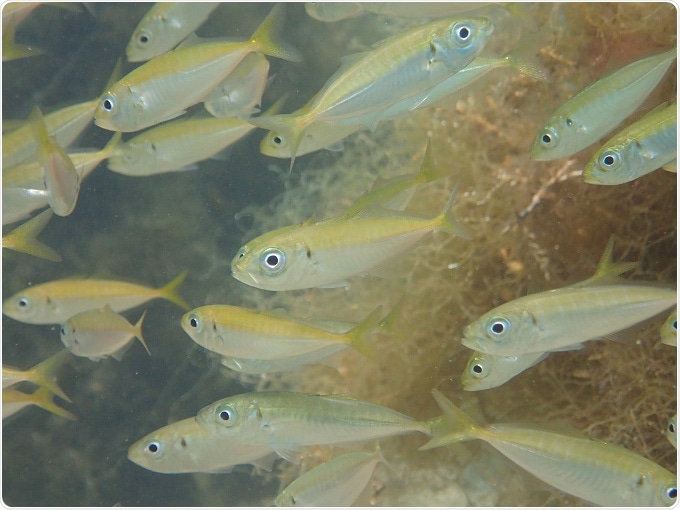Seawater, lake water, and river water contain DNA that belongs to organisms like plants and animals. Ecologists have started to intensely study such DNA molecules, known as environmental DNA, to evaluate how macro-organisms are distributed.

Researchers “counted” Japanese jack mackerel (Trachurus japonicus) in Maizuru Bay, Japan, through quantitative measurements of environmental DNA concentration. Image Credit: Reiji Masuda, Kyoto University.
But challenges continue to persist in quantitative applications of environmental DNA.
Now, scientists from the National Institute for Environmental Studies, Tohoku University, Shimane University, Kobe University, Hokkaido University, and Kyoto University have presented a new technique for estimating the population abundance of various fish species (or more commonly, a target aquatic species), by quantifying the levels of environmental DNA present in the water.
The research article has been published online in the Molecular Ecology journal.
The study results indicate the possibility of the proposed method for non-invasive, quantitative tracking of aquatic ecosystems.
DNA molecules, discharged by existing organisms, are carried by the flow of water and are ultimately decomposed. In a natural setting, such processes can function in a complex manner.
This complicates and limits the traditional approach of population quantification based on environmental DNA where the presence of a definite relationship between the concentration of environmental DNA and population abundance has been critical.”
Keiichi Fukaya, Study Lead Author and Research Associate, National Institute for Environmental Studies
Fukaya continued, “We thought that these fundamental processes of environmental DNA, the shedding, transport, and degradation, should be accounted for, when we estimate population abundance through environmental DNA.”
The study authors applied this concept by implementing a numerical hydrodynamic model that clearly considers the procedures to replicate the distribution of environmental DNA levels inside an aquatic region.
By solving this model in the ‘inverse direction’, we can estimate fish population abundance based on the observed distribution of environmental DNA concentrations.”
Keiichi Fukaya, Study Lead Author and Research Associate, National Institute for Environmental Studies
In Maizuru Bay, Japan, a case study performed that confirmed that the estimation of the population abundance of Japanese jack mackerel (Trachurus japonicus), achieved by the recommended technique, was similar to that of a quantitative echo sounder technique.
The idea and framework presented in this study forms a cornerstone towards quantitative monitoring of ecosystems through environmental DNA analysis. By combining field observation, techniques of molecular biology, and mathematical/statistical modeling, the scope of the environmental DNA analysis will be broadened beyond the determination of the presence or absence of target species.”
Michio Kondoh, Professor, Tohoku University
Professor Kondoh also headed the 5.5-year environmental DNA research project that was financially supported by the Japan Science and Technology Agency (CREST).
Source:
Journal reference:
Fukaya, K., et al. (2020) Estimating fish population abundance by integrating quantitative data on environmental DNA and hydrodynamic modeling. Molecular Ecology. doi.org/10.1111/mec.15530.